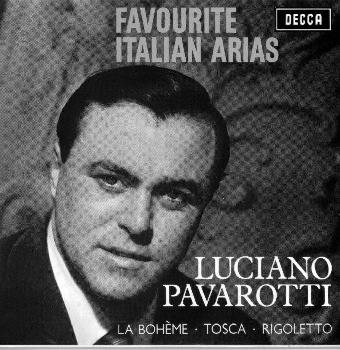Luciano Pavarotti
I wish to thank Daniele Godor for providing the recordings.
I first heard Pavarotti in the early 1960s in Zürich. The local opera house has a seat capacity of about 1200 people. In such an environment, Pavarotti sounded pleasant, his voice filling the house well. However I must say that his Duke in Rigoletto was much inferior to the one sung by Alfredo Kraus in the same house. After that I encountered him in San Francisco as Edgardo in a huge house. There, he sounded small and unexciting. His Edgardo was well below the one I heard sung by Vanzo at the Paris Opéra and Vanzo was not a Tamagno type tenor. Vanzo also characterized the role much better than Pavarotti. Pavarotti sang Rodolfo at the Paris Opéra and there he also could not be heard. With me, some friends went to hear him (or rather see him since he already had his elephantine size) based on the well orchestrated publicity on the merit of the big man. They were very disappointed. In their youth, they used to listen to Franz, Burdino, O'Sullivan, de Trévi, Thill, etc... I witnessed his Radamès in London. He was a small scale hero with the voice to go with it and had an impossible stage presence due to the handicap of his size that he could not overcome. When I moved to New York, I went to hear him as Manrico. Hear is a big word, since I was only barely able to hear a tread of voice. I left at the intermission, disgusted by his singing. During other times, Pavarotti would have been, at best, limited due to the size of his voice to what French call Opéra-comique roles and to theatre sizes going with it. The argument we hear is that he has a beautiful voice. Well, he was not the only one, what about Gigli, Caruso, Schipa, Cortis, Di Stefano, Thill, etc.? None of these singers had the small voice of Pavarotti. He is the perfect home tenor for people who do not wish to go out to hear him live, but sit at home to listen to the miracle of electronics that makes him sound robust. Pavarotti la voce di topolino. It's probably tedious to recount Pavarotti's world career, from his studies in Modena together with Mirella Freni, to his early artistic partnership with Joan Sutherland and Richard Bonynge, and to his position as the world's greatest operatic star since Maria Callas, particularly at a time when his voice was on the decline, and when he primarily sang semi-classical, semi-pop concerts, either with Domingo and Carreras as the Three Tenors, or with actual pop stars at the annual Pavarotti and Friends concerts in Modena. Rigoletto – Carpi, Comunale, 1 November 1961 La traviata – Belgrade, National, 3 December 1961 Lucia di Lammermoor – Amsterdam, Nederlandse Opera, 18 January 1963 Madama Butterfly – Belfast, Grand Opera House, 7 May 1963 Idomeneo (Idamante) – Glyndebourne, 24 July 1964 La sonnambula – London, Covent Garden, 26 May 1965 L'elisir d'amore – Melbourne, Her Majesty's, 15 July 1965 I Capuleti e i Montecchi – Milano, Scala, 26 March 1966 La fille du régiment – London,Covent Garden, 2 June 1966 I puritani – Catania, Bellini, 22 March 1968 Manon – Milan, Scala, 31 May 1969 I lombardi alla prima crociata – Rome, Opera, 20 November 1969 Un ballo in maschera – San Francisco, Opera, 27 October 1971 La favorita – San Francisco, Opera, 7 September 1973 Luisa Miller – San Francisco, Opera, 23 November 1974 Der Rosenkavalier – New York, Met, 8 March 1976 Il trovatore – New York, Met, 11 October 1976 Tosca – Chicago, Lyric, 26 November 1976 L'elisir d'amore – Hamburg, Staatsoper, 18 June 1977 Turandot – San Francisco, Opera, 30 December 1977 La Gioconda – San Francisco, Opera, 7 September 1979 Aida – San Francisco, Opera, 12 November 1981 Idomeneo (Idomeneo) – New York, Met, 14 October 1982 Ernani – New York, Met, 18 November 1983 Otello – Chicago, concert, 16 April 1991 Don Carlo – Milano, Scala, 7 December 1992 Andrea Chénier – New York, Met, 6 April 1996 Reference: Martin Mayer, Gerald Fitzgerald Grandissimo Pavarotti, Doubleday & Company, Inc., Garden City, New York, 1986. |
